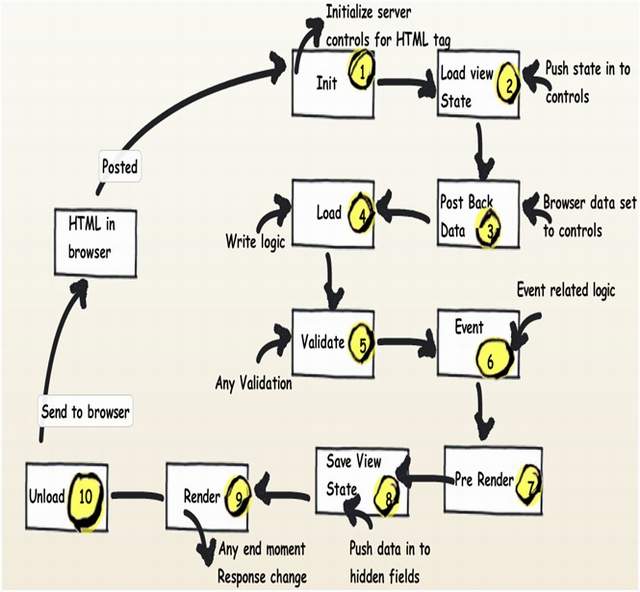I was asked to explain the ASP.NET page life cycle in an interview some time back. I did explain it to him, but he was not satisfied with my answer. Could someone explain the life cycle to me please?
ASP.NET page life cycle explanation
Asked Answered
There are 10 events in ASP.NET page life cycle, and the sequence is:
- Init
- Load view state
- Post back data
- Load
- Validate
- Events
- Pre-render
- Save view state
- Render
- Unload
Below is a pictorial view of ASP.NET Page life cycle with what kind of code is expected in that event. I suggest you read this article I wrote on the ASP.NET Page life cycle, which explains each of the 10 events in detail and when to use them.
Image source: my own article at https://www.c-sharpcorner.com/uploadfile/shivprasadk/Asp-Net-application-and-page-life-cycle/ from 19 April 2010
Nice visual. I can show this to management to help them understand what I'm trying to explain about multiple trips to the database due to spaghetti code. –
Sculptor
This acronym might help you to remember the ASP.NET life cycle stages which I wrote about in the below blog post.
R-SIL-VP-RU
- Request
- Start
- Initialization
- Load
- Validation
- Post back handling
- Rendering
- Unload
From my blog: Understand ASP.NET Page life cycle and remember stages in easy way
18 May 2014
It's important to provide explicit disclosure of any affiliation to avoid your posts being flagged as spam. I noticed all of your answers on SO were posted with a link to the same blog (in fact, the entire content of each answer relies heavily on said link), where each specific link was to a specific blog article posted less than a single day before each of your respective answers were posted. –
Monda
Also, this acronym is not at all easy to commit to memory. Perhaps a mnemonic like "RSVP, Russia" for "Répondez S'il Vou Plaît, Russia" would be easier? –
Monda
Partial Class _Default
Inherits System.Web.UI.Page
Dim str As String
Protected Sub Page_Disposed(sender As Object, e As System.EventArgs) Handles Me.Disposed
str += "PAGE DISPOSED" & "<br />"
End Sub
Protected Sub Page_Error(sender As Object, e As System.EventArgs) Handles Me.Error
str += "PAGE ERROR " & "<br />"
End Sub
Protected Sub Page_Init(sender As Object, e As System.EventArgs) Handles Me.Init
str += "PAGE INIT " & "<br />"
End Sub
Protected Sub Page_InitComplete(sender As Object, e As System.EventArgs) Handles Me.InitComplete
str += "INIT Complte " & "<br />"
End Sub
Protected Sub Page_Load(sender As Object, e As System.EventArgs) Handles Me.Load
str += "PAGE LOAD " & "<br />"
End Sub
Protected Sub Page_LoadComplete(sender As Object, e As System.EventArgs) Handles Me.LoadComplete
str += "PAGE LOAD Complete " & "<br />"
End Sub
Protected Sub Page_PreInit(sender As Object, e As System.EventArgs) Handles Me.PreInit
str = ""
str += "PAGE PRE INIT" & "<br />"
End Sub
Protected Sub Page_PreLoad(sender As Object, e As System.EventArgs) Handles Me.PreLoad
str += "PAGE PRE LOAD " & "<br />"
End Sub
Protected Sub Page_PreRender(sender As Object, e As System.EventArgs) Handles Me.PreRender
str += "PAGE PRE RENDER " & "<br />"
End Sub
Protected Sub Page_PreRenderComplete(sender As Object, e As System.EventArgs) Handles Me.PreRenderComplete
str += "PAGE PRE RENDER COMPLETE " & "<br />"
End Sub
Protected Sub Page_SaveStateComplete(sender As Object, e As System.EventArgs) Handles Me.SaveStateComplete
str += "PAGE SAVE STATE COMPLTE " & "<br />"
lbl.Text = str
End Sub
Protected Sub Page_Unload(sender As Object, e As System.EventArgs) Handles Me.Unload
'Response.Write("PAGE UN LOAD\n")
End Sub
End Class
© 2022 - 2024 — McMap. All rights reserved.

